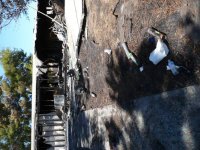http://www.sacbee.com/news/local/article149599239.html
New butane restrictions add roadblock to making hash oil in Sacramento County
BY ELLEN GARRISON
egarrison@sacbee.com
Butane has long fueled camp stoves and cigarette lighters. But some residents are buying gallons of the gas for another purpose – producing the marijuana concentrate known as hash oil.
For that reason, Sacramento County Supervisor Phil Serna questions why liquor stores stock large quantities of butane, as he’s noticed in the South Oak Park neighborhood in his district.
Serna and other supervisors unanimously voted Tuesday to limit the amount of butane that retailers in the county can sell to 600 milliliters, roughly equal to a British pint glass. The ordinance also would require local sellers to log the sale date, quantity and customer information. Residents will only be able to possess 600 milliliters at any given time.
County leaders are particularly concerned that explosions linked to butane hash oil labs have been on the rise for the last decade.
“That caused me to reflect on whether or not my constituents are in that much of a dire need for that much butane,” Serna said. “Knowing what I know about the process for extracting cannabinoids. ... I saw the need immediately for there to be some sort of intervention.”
Hash oil, sometimes called honey oil, is made by cramming marijuana into a tube and running butane through it. That strips THC – the ingredient that produces a high – from the plant matter.
The liquid that comes out the tube’s bottom is then heated to evaporate the butane. What remains is a waxy substance that can be smoked, used in edibles or placed in e-cigarettes.
The evaporation part of the process can be deadly. Refined butane vapor is clear, odorless and heavier than air, so it sinks to the ground and can gather in enclosed spaces. It’s highly flammable, so any tiny flare is enough to cause an explosion, such as a spark from a wall outlet or a refrigerator motor.
Components of a butane hash oil lab are fairly inexpensive and tutorials on making the substance are easy to come by – a Google search turns up dozens of how-to guides.
Sacramento Fire Department Captain Mike Feyh said one or two 300-milliliter cans hold enough butane to blow up an entire apartment. He said some makers don’t realize that if there’s a leak in their system, a spark is all that’s needed to cause an explosion.
Dr. David Greenhalgh, chief of the burn division at UC Davis Medical Center, said patients tied to butane explosions began showing up in the burn ward around 2007. Since then, the number of patients per year has grown to about 30 out of 400, about 7 percent of all burn patients.
While average patients have burns on 8 percent to 10 percent of their bodies, people caught in butane explosions have burns on 30 percent of their body on average, he said. In some cases, burns cover 70 to 90 percent of a patient’s body.
Hospital stays for burns work out to roughly a day per percent burned, he said.
“They can be in for five, six, seven months in critical care units,” Greenhalgh said. “We’re talking lots of money. ... They’re not always the highest-insured kinds of people.”
Greenhalgh said exact numbers are hard to determine because people in butane explosions sometimes lie about the source of the fire. He compared the proliferation of hash oil labs to methamphetamine labs in the 1990s that relied on the cold drug pseudoephedrine.
“When they got control of the pseudoephedrine, they stopped having that (meth lab explosion) problem,” Greenhalgh said. Federal Drug Enforcement Administration statistics show incidents involving meth labs fell from 180 in California in 2010 to 47 in 2014.
The Sacramento County ordinance is on track to take effect June 22. It will ban sales of butane over 600 milliliters in Sacramento County, but a three-pack of 300 milliliter cans is available on Amazon for $19.99. The gas can legally be used to refill lighters and power camp stoves.
The ordinance does not restrict the purchase of butane with odor added – the smell lingers in the hash oil, so manufacturers don’t use it.
Feyh is working with Assemblyman Jim Cooper, D-Elk Grove, and firefighter organizations to pass Assembly Bill 1120, which would put the same regulations in place statewide. The bill is currently in the Assembly Appropriations Committee.
Feyh said butane hash oil labs used to be more of a rural problem, and cities such as Red Bluff and Eureka passed ordinances restricting butane. But recently, labs have emerged in more suburbs and urban areas, he said.
“People could be doing it next door and you would never know,” he said.
New butane restrictions add roadblock to making hash oil in Sacramento County
BY ELLEN GARRISON
egarrison@sacbee.com
Butane has long fueled camp stoves and cigarette lighters. But some residents are buying gallons of the gas for another purpose – producing the marijuana concentrate known as hash oil.
For that reason, Sacramento County Supervisor Phil Serna questions why liquor stores stock large quantities of butane, as he’s noticed in the South Oak Park neighborhood in his district.
Serna and other supervisors unanimously voted Tuesday to limit the amount of butane that retailers in the county can sell to 600 milliliters, roughly equal to a British pint glass. The ordinance also would require local sellers to log the sale date, quantity and customer information. Residents will only be able to possess 600 milliliters at any given time.
County leaders are particularly concerned that explosions linked to butane hash oil labs have been on the rise for the last decade.
“That caused me to reflect on whether or not my constituents are in that much of a dire need for that much butane,” Serna said. “Knowing what I know about the process for extracting cannabinoids. ... I saw the need immediately for there to be some sort of intervention.”
Hash oil, sometimes called honey oil, is made by cramming marijuana into a tube and running butane through it. That strips THC – the ingredient that produces a high – from the plant matter.
The liquid that comes out the tube’s bottom is then heated to evaporate the butane. What remains is a waxy substance that can be smoked, used in edibles or placed in e-cigarettes.
The evaporation part of the process can be deadly. Refined butane vapor is clear, odorless and heavier than air, so it sinks to the ground and can gather in enclosed spaces. It’s highly flammable, so any tiny flare is enough to cause an explosion, such as a spark from a wall outlet or a refrigerator motor.
Components of a butane hash oil lab are fairly inexpensive and tutorials on making the substance are easy to come by – a Google search turns up dozens of how-to guides.
Sacramento Fire Department Captain Mike Feyh said one or two 300-milliliter cans hold enough butane to blow up an entire apartment. He said some makers don’t realize that if there’s a leak in their system, a spark is all that’s needed to cause an explosion.
Dr. David Greenhalgh, chief of the burn division at UC Davis Medical Center, said patients tied to butane explosions began showing up in the burn ward around 2007. Since then, the number of patients per year has grown to about 30 out of 400, about 7 percent of all burn patients.
While average patients have burns on 8 percent to 10 percent of their bodies, people caught in butane explosions have burns on 30 percent of their body on average, he said. In some cases, burns cover 70 to 90 percent of a patient’s body.
Hospital stays for burns work out to roughly a day per percent burned, he said.
“They can be in for five, six, seven months in critical care units,” Greenhalgh said. “We’re talking lots of money. ... They’re not always the highest-insured kinds of people.”
Greenhalgh said exact numbers are hard to determine because people in butane explosions sometimes lie about the source of the fire. He compared the proliferation of hash oil labs to methamphetamine labs in the 1990s that relied on the cold drug pseudoephedrine.
“When they got control of the pseudoephedrine, they stopped having that (meth lab explosion) problem,” Greenhalgh said. Federal Drug Enforcement Administration statistics show incidents involving meth labs fell from 180 in California in 2010 to 47 in 2014.
The Sacramento County ordinance is on track to take effect June 22. It will ban sales of butane over 600 milliliters in Sacramento County, but a three-pack of 300 milliliter cans is available on Amazon for $19.99. The gas can legally be used to refill lighters and power camp stoves.
The ordinance does not restrict the purchase of butane with odor added – the smell lingers in the hash oil, so manufacturers don’t use it.
Feyh is working with Assemblyman Jim Cooper, D-Elk Grove, and firefighter organizations to pass Assembly Bill 1120, which would put the same regulations in place statewide. The bill is currently in the Assembly Appropriations Committee.
Feyh said butane hash oil labs used to be more of a rural problem, and cities such as Red Bluff and Eureka passed ordinances restricting butane. But recently, labs have emerged in more suburbs and urban areas, he said.
“People could be doing it next door and you would never know,” he said.

































